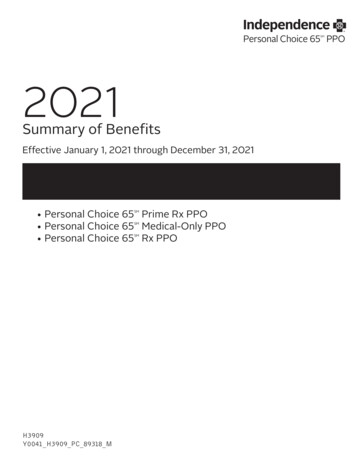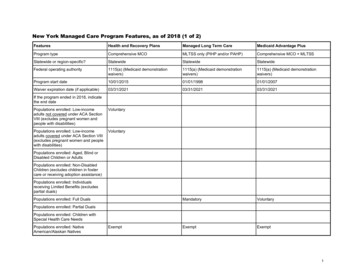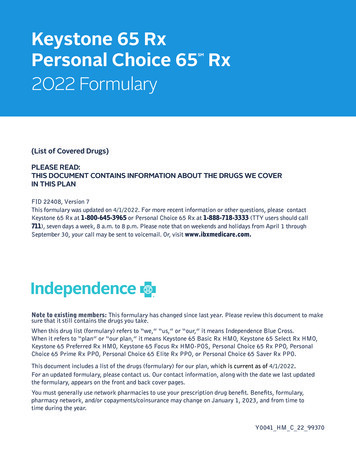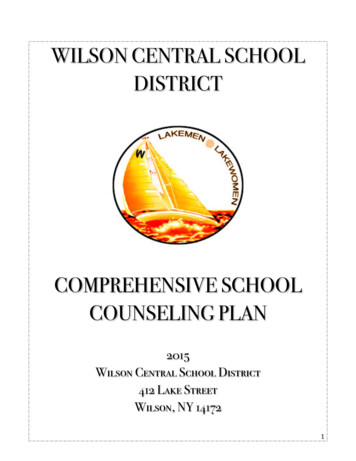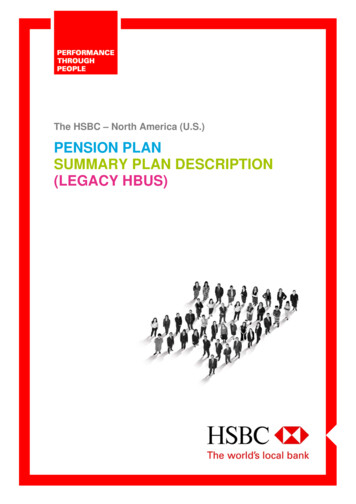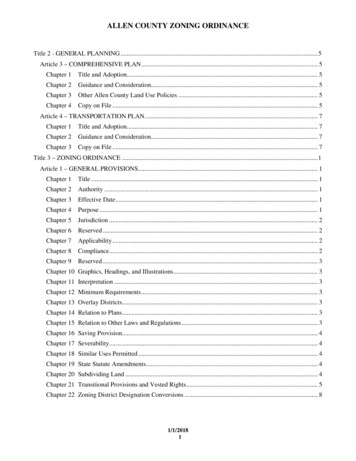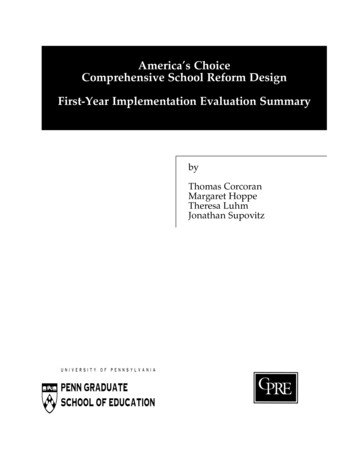
Transcription
America’s ChoiceComprehensive School Reform DesignFirst-Year Implementation Evaluation SummarybyThomas CorcoranMargaret HoppeTheresa LuhmJonathan Supovitz
ABOUT CPREThe Consortium for Policy Research in Education (CPRE) unites five of the nation’s topresearch institutions in an exciting venture to improve student learning through research onpolicy, finance, school reform, and school governance. The members of CPRE are the Universityof Pennsylvania, Harvard University, Stanford University, the University of Michigan, and theUniversity of Wisconsin-Madison.CPRE is currently examining how alternative approaches to reform such as new accountabilitypolicies, teacher compensation, whole-school reform approaches, and efforts to contract outinstructional services address issues of coherence, incentives, and capacity.To learn more about CPRE, visit our web site at www.upenn.edu/gse/cpre/ or call (215) 5730700, and then press 0 for assistance.ABOUT AMERICA’S CHOICEThe National Center on Education and the Economy (NCEE) is the nation’s leader in standardsbased education. NCEE’s founders created this not-for-profit organization in the conviction thatvirtually all young people in the United States can and must achieve at the same high standardsreached by their counterparts in other nations. NCEE exists to develop the policies and tools andprovide the professional development and technical assistance that schools, districts, and statesneed to implement comprehensive programs of standards-based education and training. NCEEhas made a special commitment to meeting the needs of low-income and minority youth.The America’s Choice School Network, originally NCEE’s National Alliance for RestructuringEducation (NARE), offers a comprehensive, research-based design for schools and districtscommitted to standards-based education. NARE was named as one of the proven design modelsin the federal Obey-Porter legislation that provides grant funding for the Comprehensive SchoolReform Demonstration (CSRD) program.To learn more about America’s Choice, please call (202) 783-3668. You can also findinformation on the world wide web at www.ncee.org/ac/intro.html.
America’s ChoiceComprehensive School Reform DesignFirst-Year Implementation Evaluation SummaryThomas Corcoran,University of PennsylvaniaMargaret Hoppe,MRH EvaluationsTheresa Luhm,University of PennsylvaniaJonathan Supovitz,University of PennsylvaniaConsortium for Policy Research in EducationGraduate School of EducationUniversity of PennsylvaniaFebruary 2000Copyright 2000 by the Consortium for Policy Research in Education
America’s Choice, Comprehensive School Reform Design: First-Year Implementation Evaluation Summary1I. INTRODUCTIONIn the fall of 1998, the National Center on Education and the Economy (NCEE) contracted withthe Consortium for Policy Research in Education (CPRE) to conduct the evaluation of theAmerica’s Choice School Design. This is a summary of CPRE’s first report of a three-yearevaluation of the design. The evaluation of America’s Choice seeks to answer four basicquestions: Are schools successfully implementing the America’s Choice program design? Whatenvironmental characteristics are facilitating or impeding implementation? How effective isAmerica Choice’s implementation strategy? And what are the impacts of the program onteachers and students? As America’s Choice is still in the early stages of implementation, mostevaluation efforts are directed toward the questions about the implementation of the program andthe conditions surrounding its implementation. In subsequent years, CPRE increasingly willemphasize its evaluation of the impacts of the program on students.This report describes the first year of the implementation of America’s Choice. Following thisintroduction, section two provides a description of America’s Choice and the theory behind theAmerica’s Choice school design. Section two concludes with a set of reasonable expectations forthe progress of America’s Choice in its first year. Section three describes CPRE’s findingsconcerning the implementation of America’s Choice, including many of the specific designcomponents. Section four analyzes the role of the school district in the implementation ofAmerica’s Choice. The report concludes with a summary of the findings of the first year’sevaluation.This report is primarily based upon six data sources. First, CPRE researchers conductedtelephone interviews with 21 design coaches and literacy coordinators across multiple America’sChoice schools. Second, CPRE visited ten schools, observed model classrooms and classroomsin which core assignments were being taught, and interviewed over 60 school staff members.Third, CPRE developed, disseminated, collected, and analyzed the results of a survey of thepopulation of teachers and Leadership Team members in all 41 Cohort I America’s Choiceschools.1 In all, about 1,900 surveys were distributed, with a 63 percent return rate. Fourth,CPRE attended several of the NCEE professional development sessions to train America’sChoice school leaders. Fifth, CPRE interviewed virtually all key NCEE staff. Finally, CPREstaff reviewed much of the relevant America’s Choice documentation, including trainingmanuals, curriculum materials, and other NCEE documents.II. DESCRIPTION OF AMERICA’S CHOICEThe America’s Choice School Design is a K-12 comprehensive school reform model designedby the National Center on Education and the Economy. America’s Choice focuses on raisingacademic achievement by providing a rigorous standards-based curriculum and safety net for allstudents. The key features of the America’s Choice School Design include:1A list of the participating schools is provided in the Appendix.
2America’s Choice, Comprehensive School Reform Design: First-Year Implementation Evaluation Summary Five design tasks standards and assessments, learning environments,community services and supports, high-performance management, andparent and public engagement.The New Standards Performance Standards.The New Standards Reference Exams.Curriculum aligned to the standards.A safety net for all students.Class teachers who follow students for three years.A planning and management system focused on results.On-site continuous technical assistance.A comprehensive professional development program.In most cases, the primary reason a school or district chose to implement America’s Choice wasa history of low student achievement. Many schools are under district or state pressure to raiseachievement levels. School and district administrators generally explored several whole schoolreform models before deciding to adopt America s Choice because they believed it would helpthem accomplish their goal.Over 80 percent of a school faculty should indicate their commitment to the America s Choicedesign and agree to implement the program over three years. Each school must assign personnelas a design coach who coordinates the reform effort and acts as a liaison to NCEE, as a literacycoordinator who introduces the literacy program to the school staff, and as a community outreachcoordinator who ensures that students get needed support services. In addition, schools mustprovide tutoring and other assistance to students falling behind, participate in America’s Choiceprofessional development sessions, and use the New Standards Reference Exams. Additionallyschools need the support of their district administration and must reserve 65,000 to 95,000 ayear for three years to contract with America’s Choice for training, materials, and on-siteassistance.THE THEORY BEHIND AMERICA’S CHOICEAmerica’s Choice does not offer schools a script or a paint-by-numbers approach to reformedinstruction. Rather, the core of the design is a set of basic principles about the purpose ofschooling and how schools should operate and a set of tools for building a program based onthose principles. The essential principles are as follows: High expectations for student performance should be explicitly expressed in acomprehensive set of performance standards that drive the work of teachers and students.These standards should be made concrete through examples of student work that serve asbenchmarks.A common core curriculum should be aligned with the standards and understood byeveryone. America’s Choice organizes the life of a school around such a core curriculum.
America’s Choice, Comprehensive School Reform Design: First-Year Implementation Evaluation Summary3Ideally, the topics and the materials are known by the teachers, the curriculum structure isunderstood by parents, and there is a strong commitment by all to getting the students towhere they need to be. Performance standards specify what students should know and be able to do at certainjunctures, but also provide concrete examples of student work that link the standards tostudent performance. Assessments should be aligned with the core curriculum that provide incentives forteachers and students to do the work and that provide feedback for identifying andcorrecting deficiencies in the program or in the work of students and teachers. An orientation to results focuses on how resources are used, gaps in the curriculum, andgaps in knowledge. Extended time for literacy that includes a 2 ½ hour block for students in grades K-3 anda 2 hour block for students in grades 4-5. Students who are performing below grade-levelin grades 6-12 are provided with a 2 hour literacy block for extra support. An understanding that time is a precious resource for both teachers and students andshould be used purposefully. A commitment to teacher professionalism seeks to enable teachers to function as fullprofessionals by requiring a high-quality professional development program that isaligned with the standards and in which content and pedagogy are intimately connected. A compassionate commitment to students. America’s Choice views students as changeagents because they will both demonstrate and demand the rituals and routines that havebeen effective for them, and the model understands that some students will need specialassistance or more time to succeed. Providing access to high-quality support by requiring schools to have a full-time designcoach and a full-time literacy coordinator who receive extensive training by NCEE. The formation of a school Leadership Management Team to coordinateimplementation, to ensure the necessary resources for implementation, and to align otherschool activities with implementation of the design. Using the power of demonstration to persuade teachers to try new approaches to literacyteaching. Literacy coordinators make it real in their own classrooms, and when they cando it themselves, they can show it to others. The America’s Choice design begins theprocess of changing instruction with writing. This establishes the credibility of the designby demonstrating improvement in student work prior to challenging deeply held beliefsabout reading instruction.
4 America’s Choice, Comprehensive School Reform Design: First-Year Implementation Evaluation SummaryAmerica’s Choice recognizes that the pace of change will vary from school to school andthe model does not have a rigid three-year implementation schedule.Schools need models that show the way and they need tools and exemplars to build thescaffolding that will support their new architecture until it is institutionalized and self-sustaining.In support of these principles, America’s Choice offers a set of tools and building blocks thatallow school staffs to transform the standards into a curriculum, a schedule, and anorganizational design that sustains the focus on the standards and the results.What are some of these tools and building blocks? All America’s Choice schools are expected touse the New Standards Performance Standards and the related Reference Exams. Otherassessment instruments such as portfolios have been developed to provide richer informationabout students and make it easier to observe, share, and discuss student work. America’s Choicealso provides core curriculum units that will eventually cover more than 100 instructional days.At present, America’s Choice offers teachers a clear and explicit vision of good practice forliteracy teaching and learning aligned with the standards, and it will eventually offer acomplementary vision in mathematics. Further, there are ideas about scheduling that focus largeblocks of time on literacy and mathematics. There are also notions about staffing andorganization that build stronger relationships between adults and students by keeping themtogether from grade to grade. Safety nets provide support and extra instructional time forstudents when needed. There are even special curricula to help students catch up. Testedapproaches to involving parents in their children’s education are still another component of thedesign. The America’s Choice design seeks to develop a school’s internal capacity for continuedimprovement. The designers believe that, if the building blocks are put into place, used well andsustained, then a school will experience substantial and lasting performance gains.EXPECTATIONS FOR THE FIRST YEAR OF AMERICA'S CHOICEThe 1998-99 school year was the first year of implementation in schools choosing the America’sChoice School Design. In some cases, schools did not begin implementation until mid-year. Thefocus of the first year of any reform initiative is on putting the new infrastructure in place and onhelping teachers and administrators to learn new roles and new skills. The America’s Choicedesign assumes that it will take time to produce changes in teaching and learning. However, theevaluation team believes that it is reasonable in the first year to expect the following: A clear vision of reform is emerging and is shaping decisions at all levels of the school. Staff in each America’s Choice school understand the theory underlying the reform,understand what is expected of them, and some begin to behave in ways that realize thepotential of the reform. New structures required by the design, such as the Leadership Management Team, havebeen put in place and are functional in each school.
America’s Choice, Comprehensive School Reform Design: First-Year Implementation Evaluation Summary 5Teachers and school administrators are beginning to make changes consistent with thereforms; there are indications those reforms are reaching classrooms and affectingstudents.III. IMPLEMENTATION FINDINGSAmerica’s Choice schools made substantial headway in their first year of implementation of thedesign. Our survey and interview analyses suggested that school staff were supportive ofstandards and quickly accepted the design requirements. They implemented school-wide featuressuch as the 25 Book Campaign and Book of the Month, and literacy coordinators developedmodel classrooms. Although training time was limited, design coaches worked with staff so theyunderstood the America’s Choice design, became familiar with New Standards PerformanceStandards, and administered the New Standards Reference Exams. Schools instituted LeadershipManagement Teams that worked on finding ways to extend learning time and establish safety netprograms.In this section of the report, we discuss our findings about the implementation of America’sChoice in the 1998-99 school year. As an organizing structure, we first discuss findings aboutthe design in general, and then we look in greater depth at the implementation of components ofthe design including standards, assessments, the literacy program, and the high performancemanagement system. This serves only as a loose structure, however, since the components of thedesign are intimately interrelated.THE AMERICA’S CHOICE DESIGNIn less than one year, most schools made some headway in moving practice closer to theAmerica’s Choice design. Our survey and interview data identified the extent to which schoolswere using strategies required by the America’s Choice design: 25 Book Campaign. In all but one school we visited, staff were implementing the 25Book Campaign and the Book of the Month as a result of adopting America’s Choice.Sixty percent of the language arts teachers were using the 25 Book Campaign with theirstudents. More model classroom teachers (83 percent) than language arts teachers (60percent) were participating. Over half of the K-8 language arts teachers reportedimplementing the 25 Book Campaign; far more grades 3-5 language arts teachers (75percent) were doing so than teachers of grade 9-12 (17 percent). Posting Standards in the Classroom. Over two-thirds of the teachers reported postingstandards in their classrooms; 75 percent of teachers reported that they displayed modelsof student work that met standards. During our visits in the spring of 1999, we observedstandards posted in many classrooms, but more frequently, these were state contentstandards, not New Standards Performance Standards. Posted student work oftenrepresented all the students in the class, not just work representative of the standards.
6America’s Choice, Comprehensive School Reform Design: First-Year Implementation Evaluation SummaryA Consecutive Instructional Block for English Language Arts. Less than 40 percent ofthe teachers reported having a consecutive block of time for reading and writing. Only ahandful of schools that we visited had a consecutive block for English language arts, andthese were elementary schoolsTeacher Agreement with Statementsthat had instituted this practiceabout Design Componentsprior to implementing100America’s Choice. We found716875one high school that had a5250double language arts block forstudents performing below25state standards, but again this0was instituted prior to theBefore/afterStandards areSchool library hasschool programs inposted in myenough books foradoption of America’s Choice.placeclassroom25 Book CampaignWe did find that schools wereexploring how to implement aconsecutive block in the 1999-2000 school year for some, if not all, grades. A Two and One-half Hour Block for English Language Arts. Over 70 percent of the K5 teachers reported more than six hours a week allocated to literacy, as compared to 36percent of language arts teachers of grades 6-8 and 15 percent of the grades 9-12language arts teachers. Based upon teachers’ survey results, the average time spent perday on reading and writing in grades K-2 was 130 minutes, and it was 128 minutes ingrades 3-5. Instruction time for reading and writing in grades 6-8 dropped to 101minutes per day and to 87 minutes in grades 9-12. Teaching Different Genres. More grades 3-5 language arts teachers reported teachingresponses to literature (90 percent), reports (78 percent), narrative accounts (84 percent)and narrative procedures (61 percent). By contrast, more grades 9-12 language artsteachers taught reflective essays (64 percent) and persuasion (58 percent). Very few K-2language arts teachers taught reflective essays, persuasion, or narrative procedures, whichwere not normally part of their curriculum. Use of Leveled Texts. More grades 6-8 language arts teachers (48 percent) reported usingleveled texts in their classrooms than K-2 language arts teachers (39 percent), grades 3-5language arts teachers (40 percent), or grades 9-12 language arts teachers (28 percent).This pattern may be due to misinterpretation related to basal reading systems, which havestories written on grade level but are not leveled literature books. Resources for Core Assignments (fiction and non-fiction books). About 60 percent ofthe K-8 language arts teachers reported using classroom libraries as central to instruction,as compared to less than half of the grades 9-12 language arts teachers.Full-day Kindergarten. All but one of the schools we visited had a full-day kindergartenin operation prior to the adoption of America’s Choice.% Agreement
America’s Choice, Comprehensive School Reform Design: First-Year Implementation Evaluation Summary7 Teachers Staying with Students for Three Years. About 30 percent of the teacherscurrently stayed with students over multiple years. Some elementary teachers werestaying with students for two years, but none for three years. Safety Net Programs: Before and After School and Saturday. Over two-thirds of theteachers reported there were programs before or after school for students who neededmore time; less than one-third reported Saturday programs or that the school schedulewas built to provide additional time for students in need. Sixty-one percent of principalsreported there were before or after school programs for students, and 52 percent reportedassistance was available on Saturday. Safety Net Programs: Summer School. All the districts we visited had summerprograms, but about half were either enrichment programs or were programs only forstudents not reaching benchmarks. Half of the grades 6-12 language arts teachersreported that summer school was mandatory for those who finished the year below gradelevel in literacy or mathematics, but only about 30 percent of the K-5 language artsteachers reported this to be the case. America’s Choice Approach to Discipline. In the schools we visited, model classroomteachers had established rituals and routines in their classrooms and felt this reduceddiscipline problems. About half of the schools reported that they were working on adiscipline policy, and the others had postponed it until next year because all their effortswere focused on other America’s Choice components such as model classrooms, Englishlanguage arts blocks, and the 25 Book Campaign.Despite many challenges, design coaches and literacy coordinators were rolling out theAmerica’s Choice design within four months of training. Our interviews with design coachesand literacy coordinators four months after their first training suggested that implementation hadprogressed in every elementary school, although its extent and breadth varied. Design coacheshad begun introducing staff to the America’s Choice design elements and New StandardsPerformance Standards, and literacy coordinators had conducted training on the Writer’sWorkshop and begun setting up model classrooms. Most had a clear understanding of their rolesand, with the exception of two schools, had moved the school staff into work on the design.Some design coaches and literacy coordinators were making presentations to parents through thePTA, and parents were requesting information about books and writing. In all of the schools wevisited, Book of the Month had been instituted and there was a high level of receptivity from thestudents and the staff. Others were enthusiastically engaging teachers in the 25 Book Campaign,using rubrics to assess student work, and planning how to change the discipline policy. Somehad formed Leadership Management Teams, often blending them with existing school-basedmanagement committees. The Leadership Management Teams were making progress in ensuringthat America’s Choice was part of the dialogue on school change and improvement. In a fewschools we visited, progress was slower; they had only implemented one or two training sessionsand the Book of the Month. These were settings with many obstacles to implementation, butoptimism was high that more tasks would be completed as the year unfolded.
8America’s Choice, Comprehensive School Reform Design: First-Year Implementation Evaluation SummaryThe following factors influenced the implementation progress of the America’s Choice design: Principal Support. Principals generally were supportive and their support grew after thenational conference in January. Both design coaches and literacy coordinators reportedthat principals were supporting their efforts by finding time for staff training, procuringresources, and assisting in selecting teachers for model classrooms. Multiple Jobs. Many of the design coaches we interviewed had not been released fromother job responsibilities. Most were assistant principals and a few were Title I teachersor staff developers. Design coaches were performing their regular job responsibilities asthey conducted America’s Choice training and found this extremely stressful. Resource Shortages. Shortages of resources occurred at different levels. In some schools,the resources for buying books for running records or the 25 Book Campaign were notavailable. Districts often provided fiscal support, but it took time to obtain it and time toprocure books. Some experienced difficulty in obtaining the furniture and materialsneeded to organize model classrooms. Several design coaches reported having difficultyobtaining sufficient copies of the America’s Choice materials. These problems delayedtraining of all staff in a timely fashion and implementing the required tasks of the design. Teacher Resistance. Both design coaches and literacy coordinators reported experiencingsome resistance from staff, but the extent varied by school, grade, and experience of theteacher. Some found that resistance came primarily from experienced teachers. Limited Time for Professional Development. A consistent challenge was the limitedtime available for professional development. Most schools and districts had already settheir training schedules for the year, and there was little or no available time in thecalendar for staff training in America’s Choice. Union contracts prohibited requiringteachers to spend additional time in professional development. Some principals usedsubstitutes or teacher assistants to free teachers for training during the regular school day.Other principals used grade-level or faculty meetings for training. Some offered afterschool training and provided stipends to encourage attendance. High Schools. The roll out of America’s Choice in high schools was not progressing atthe same pace as in elementary schools. Many found it more difficult to translatecomponents of the design to departmental settings. Many high schools also were facingnew state tests, and their staffs were overwhelmed with changing curriculum to supportstudents in the new assessments. New Textbooks. Introduction of new textbooks in some districts also was interferingwith staff receptivity to the America’s Choice design. For example, in one setting, newtextbooks had been adopted for all the core subject areas, so staff were trying to learnhow to use new materials at the same time they were learning how to implementstandards. These were not major barriers to implementation, but they were often cited asissues that delayed implementing design activities or caused staff resistance.
America’s Choice, Comprehensive School Reform Design: First-Year Implementation Evaluation Summary9Overall, design coaches and literacy coordinators reported they were moving forward and tryingto meet the expectations set in their training. All were concerned they were behind schedule, butmost were pleased with the receptivity of staff and students.Teachers in the America’s Choice schools were supportive of the design. Almost 90 percentreported that America’s Choice had the potential to benefit students; about two-thirds reportedthat it was a unifying strategy for the different programs in the school and was consistent withother programs in the school. Those deeply engaged in America’s Choice were more positivethan all language arts or other academic teachers.When we interviewed teachers in the spring of 1999, we also spoke to individuals who were lesssupportive of the America’s Choice design. Their criticisms fell into four categories: not likingwhole school reform in general; not supporting how America’s Choice became the school’sapproach to whole school reform; not understanding or liking specific aspects of America’sChoice; or not seeing the requisite resources to implement the America’s Choice requirements.The issues or concerns that teachers voiced, for the most part, demonstrated a lack ofunderstanding and preparation for America’s Choice strategies, such as the scoring rubric, ratherthan flaws in the design. Many teachers were confused by the New Standards Reference rubrics.Some were concerned that the New Standards Reference rubric was not consistent with the staterubrics; others thought the New Standards rubric was too difficult. In addition, some teachersvoiced concern about resources. Some teachers lacked confidence that their colleagues couldteach the design correctly and felt the only way to learn it was through seeing a classroom inanother school or a demonstration by an NCEE staff member.There was a considerable range in the degree to which the design had penetrated schoolcultures. Both survey data and site observations suggest that there is extensive variation in theextent to which teachers and administrators have confidence in the underlying theories aboutteaching and learning which form a foundation for the America’s Choice reform. For example,over one third of the teachers on the survey agreed that special education and English LanguageLearners should not be expected to meet the standards. Four out of ten teachers felt that studentsare not ready for problem solving until they have acquired the basics. These responses and otherssuggest that the belief systems underlying standards-based reform are not yet widely held in theschools.Principals were very positive about the America’s Choice design. In their survey responses,principals unanimously reported that they understood the purpose of the program (100 percent)and that the design was consistent with other programs in the school (94 percent). They alsoperceived the design as a unifying strategy for the school’s different programs (97 percent), andreported that the reform approach had the potential to benefit students (97 percent).The schools we visited were at different points in the America’s Choice implementationschedule. School staffs learned about the America’s Choice design in October of 1998. Overall,they made considerable progress in implementing the desi
staff reviewed much of the relevant America's Choice documentation, including training manuals, curriculum materials, and other NCEE documents. The America's Choice School Design is a K-12 comprehensive school reform model designed by the National Center on Education and the Economy. America's Choice focuses on raising

